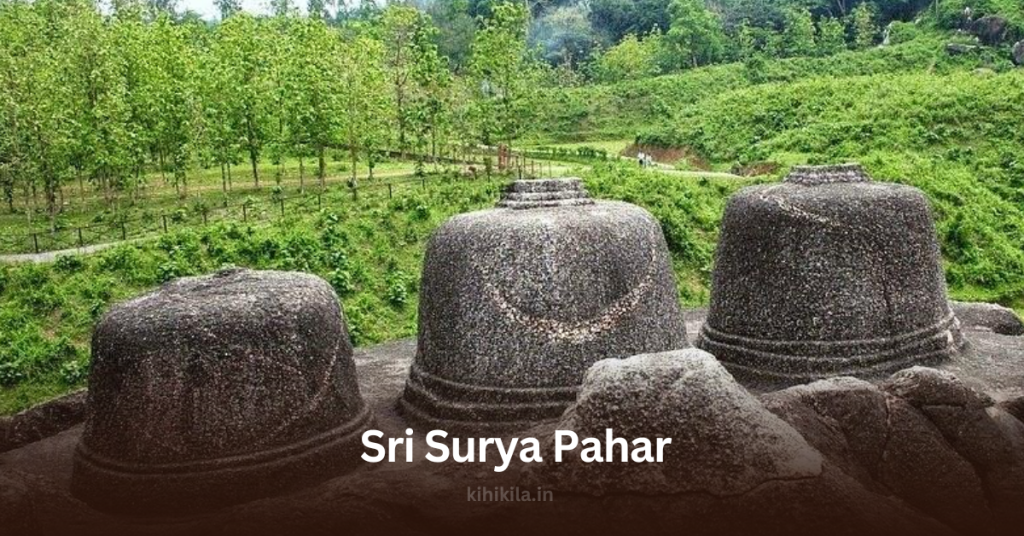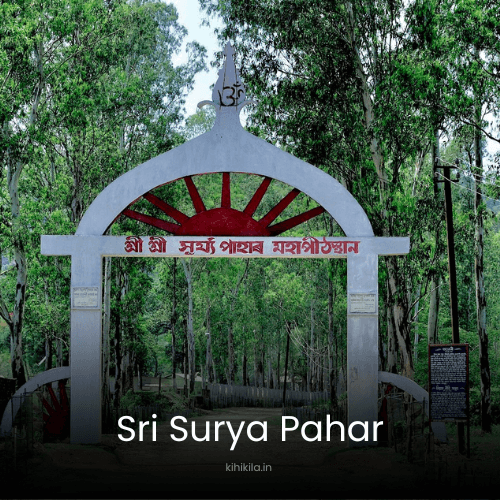Introduction
Nestled about 12 km southeast of Goalpara town in Assam, Sri Surya Pahar is an extraordinary archaeological site that has remained relatively unexplored by the masses. This site, which was once a thriving center of religious and cultural significance, is home to rock-cut Shiva Lingas, votive stupas, and ancient deities belonging to Hinduism, Buddhism, and Jainism. Spread over an expansive hilly terrain, it holds a treasure trove of historical artifacts and architectural remnants, making it a crucial site for understanding ancient Assam’s civilization and religious practices.
A Sacred Site of Religious Harmony
Sri Surya Pahar is unique in its representation of three major religions—Hinduism, Buddhism, and Jainism. Unlike other historical places that predominantly focus on a single religious sect, this site showcases a harmonious blend of beliefs that coexisted centuries ago. The presence of Shiva Lingas, Buddhist stupas, and Jain Tirthankara carvings points to the site’s deep-rooted spiritual and cultural significance.
The Mythological Connection with Pragjyotishpura

The region of Assam has historically been known as Pragjyotishpura, a name that finds mention in ancient texts such as the Kalika Purana. According to legend, Brahma created Pragjyotishpura as an equal to the city of Indra, the King of Devas. The term ‘Prag’ means ‘east,’ while ‘Jyotisha’ relates to astrology, signifying that this was once a hub of astronomical studies. Sri Surya Pahar is believed to have played a crucial role in this ancient civilization.
The Legend of 99,999 Shiva Lingas
One of the most fascinating aspects of Sri Surya Pahar is the belief that Sage Vyasa installed 99,999 Shiva Lingas in the area, intending to create a second Kashi, a place of ultimate spiritual significance. While historical records cannot confirm the exact number, the hills are still dotted with hundreds of Shiva Lingas of varying sizes, many of which remain undiscovered beneath layers of earth and vegetation.
Archaeological Discoveries and Their Significance
Recent excavations at Sri Surya Pahar have revealed stone and terracotta artifacts, temple structures, and ancient dwellings, suggesting that this was once a flourishing settlement. Some of the most notable discoveries include:
- Mahisasuramardini Sculpture: A well-crafted depiction of Goddess Durga slaying the demon Mahishasura.
- Votive Stupas: Around 25 stupas, indicative of early Buddhist influence in Assam, predating the Mahayana and Vajrayana traditions seen in Bihar and Bengal.
- Carved Bricks and Terracotta Plaques: These artistic elements provide insights into the architectural brilliance of the past.
- Jain Tirthankara Image: A significant carving of Adinath in a meditative posture with two bulls at the base, believed to date back to the 9th century AD.
These findings suggest that the history of Sri Surya Pahar could potentially reshape our understanding of ancient Assam and its role in India’s historical narrative.
The Influence of Buddhism and Jainism
Apart from being a center for Shaivism, Sri Surya Pahar has remarkable evidence of Buddhist and Jain influences. The presence of Hinayana-style stupas indicates that Buddhism thrived here much earlier than in many other parts of India. Jain influence is evident from the carvings of Tirthankaras, proving that this site was a significant pilgrimage destination for followers of multiple faiths.
The Connection with Chinese Traveler Huen Tsang
Several scholars argue that Sri Surya Pahar, rather than Guwahati, was the true ancient capital of Pragjyotishpura under the rule of Kumar Bhaskara Varman (600-650 AD). This claim is supported by references in the travel records of the Chinese traveler Huen Tsang, who visited the region in the 7th century and described a thriving Buddhist and Hindu cultural hub. Nearby archaeological sites like Paglatek further strengthen this theory.
Artistic and Architectural Marvels
Sri Surya Pahar is not just an archaeological site; it is an open-air museum that showcases the artistic mastery of ancient artisans. The intricate rock carvings, temple ruins, and well-structured stupas exhibit the refined craftsmanship of different eras. The careful arrangement of bricks in the unearthed houses suggests advanced construction techniques that were ahead of their time.
A Modern Sun Temple Amidst the Ruins
While Sri Surya Pahar is primarily known for its ancient heritage, a modern Sun Temple has been built atop the hill, continuing the legacy of sun worship in Assam. Sun worship has been an integral part of Assamese culture since ancient times, further linking this site to the region’s religious traditions.
The Lost Glory and the Need for Conservation
Despite its historical and cultural significance, Sri Surya Pahar remains largely neglected, with many of its relics exposed to natural erosion and human encroachment. Archaeologists and historians emphasize the urgent need for proper excavation and preservation efforts. Scientific documentation of the site’s artifacts can help uncover more hidden secrets and protect its invaluable heritage for future generations.
Conclusion
Sri Surya Pahar is a site of immense historical, religious, and cultural significance. With its rare combination of Hindu, Buddhist, and Jain influences, it stands as a testimony to India’s diverse spiritual history. While much remains to be explored, the findings so far indicate that this place played a crucial role in shaping the early civilization of Assam. It is high time that more attention is given to its preservation, ensuring that future generations can witness and appreciate this forgotten jewel of India’s past.
FAQ’s:
What is Sri Surya Pahar known for?
Sri Surya Pahar is an ancient archaeological site in Assam, famous for its religious and historical significance. It is home to thousands of Shiva Lingas, rock-cut sculptures, and ancient stupas that reflect the presence of Hinduism, Buddhism, and Jainism in the region.
How old is Sri Surya Pahar?
The exact age of Sri Surya Pahar is unknown, but historical records suggest that it has existed for over a thousand years. Some references from ancient texts like the Kalika Purana indicate that it was a major religious site since ancient times.
Why is Sri Surya Pahar important in Hindu mythology?
According to Hindu beliefs, sage Vyasa installed 99,999 Shiva Lingas here to make it a second Kashi (Varanasi). It is considered a sacred place where devotees come to offer prayers and seek blessings.
Is there any Buddhist influence at Sri Surya Pahar?
Yes, Sri Surya Pahar has several Buddhist stupas, which indicate that Buddhism flourished in this region centuries ago. The presence of early Hinayana-style stupas suggests that Buddhism reached Assam much earlier than many other parts of India.
Are there Jain relics at Sri Surya Pahar?
Yes, the site has Jain sculptures, including an ancient carving of Adinath, the first Tirthankara, sitting with two bulls at the base. This shows that Jainism also had a presence in this region during ancient times.
What kind of archaeological discoveries have been made at Sri Surya Pahar?
Excavations have revealed temple ruins, stone sculptures, terracotta plaques, and carved bricks. Some of these findings suggest that a well-developed civilization once existed here, which could change the historical understanding of Assam.
What makes Sri Surya Pahar unique compared to other historical sites in Assam?
Unlike most historical sites that are dedicated to one religion, Sri Surya Pahar is a rare place where Hinduism, Buddhism, and Jainism coexisted. The large number of Shiva Lingas and ancient stupas make it an extraordinary site for researchers and history enthusiasts.
What is the significance of the modern Sun Temple at Sri Surya Pahar?
A modern Sun Temple has been built on the hill to honor the ancient tradition of sun worship. Sun worship has been practiced in Assam for centuries, and this temple continues that tradition.
Has Sri Surya Pahar been mentioned in any historical records?
Some scholars believe that Sri Surya Pahar might have been the actual location of Pragjyotishpura, the capital of Kumar Bhaskara Varman’s kingdom, as mentioned in the records of the Chinese traveler Huen Tsang. This claim is supported by nearby archaeological findings.
What is the best time to visit Sri Surya Pahar?
The ideal time to visit is during the winter months, from October to February, when the weather is pleasant. The temperature ranges from 12°C to 23°C, making it comfortable for exploring the site.












